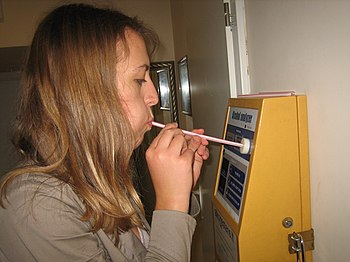In many cases, the VNM reading showing a result over a .08 is not admissible at the DUI trial:
“In cases where the Intoxilyzer 8000 registered a reading or readings of “volume not met,” however, it appears that the circuit courts have routinely concluded that such a reading was unreliable and, therefore, not valid. See Department of Highway Safety & Motor Vehicles v. Cherry, 91 So. 3d 849, 856-57 (Fla. 5th DCA 2011).
— See Kenyon v. Dep’t of High. Saf. & Motor Veh., 16 Fla. L. Weekly Supp. 899a (Fla. 4th Cir.Ct.2009) (“The machine produced a print-out that read “volume not met” which means that Petitioner was not providing a sufficient amount of breath in order for the machine to produce a valid test result.”)
— Underwood v. Dep’t of High. Saf. & Motor Veh., 15 Fla. L. Weekly Supp. 299a (Fla. 4th Cir.Ct.2008) (“The printout from the machine established that both of the samples given by Petitioner were designated as ‘Volume Not Met,’ and the machine indicated that because of this, both samples were not reliable to determine breath alcohol level”)
— Saladino v. State of Florida, Dep’t of High. Saf. & Motor Veh., 15 Fla. L. Weekly Supp. 222a (Fla. 12th Cir.Ct.2008) (“The Petitioner submitted two breath samples, but the results for both indicated ‘volume not met,’ meaning the samples were insufficient to determine Petitioner’s breath alcohol level.”).”
section 316.1932(1)(f)3., Florida Statutes
[Ms. Cherry] cites the case Unruh v. State, 669 So.2d 242
(Fla.1996) where the Florida Supreme Court held that law enforcement officers
are required to render reasonable assistance
Rule 11D-8.002(12), Florida Administrative Code (2010). Rule
11D-8.002(12) states that failure to provide the required number of valid
breath samples constitutes a refusal to submit to the breath-alcohol test.
Rule 11D-8.002(13) [sic] and regulated by section 316.1932(1)(a)2., Florida Statutes. The breath-alcohol test administered on [Ms. Cherry] was made in substantial conformity with the applicable administrative rules and statutes, Dep't of Highway Safety & Motor Vehicles v. Russell, 793 So.2d 1073
(Fla. 5th DCA 2001). Although a majority of the cases cited by [Ms.
Cherry] are not controlling in this Circuit, they are persuasive because they
are very similar factually to the instant case. See Mulligan v. State, 9 Fla. L. Weekly Supp. 146a (Fla. 7th Cir.2002); Wolok v. DHSMV, 1 Fla. L. Weekly Supp. 204a (Fla. 11th Cir. 1992); and Burson v. Collier, 226 Ga. 427,
175 S.E.2d
660 (Ga.1970).
The Supreme Court of Georgia in Burson held
that suspending a person's driver's license greatly hinders that person's use
and enjoyment of an item of that person's personal property and thus, the
statute providing the authority for the license suspension should be strictly
construed. When statutes do not explain what constitutes a "complete"
breath-alcohol test, a showing that a person did not complete the test (within
the judgment of the operator) is not evidence of a refusal to submit to a
breath-alcohol test within the contemplation of the statute. To consider this
information as evidence, would provide the operator with an unfettered right to
determine what is and what is not a complete test. Burson, 175 S.E.2d at
662.
In the instant case, the applicable Florida Statutes under
chapter 316 and 322 do not explain what constitutes a "complete"
breath-alcohol test. The breath technician and Trooper Hooker decided to
determine an "implied refusal" after the second breath-alcohol test time
frame. The Department's argument that the samples are invalid solely because
[Ms. Cherry] did not perform the test to the breath technician's satisfaction
is not persuasive. To apply the Department's argument could open the door to a
pattern of providing breath technicians and law enforcement officers with
unrestrained power when determining what is and what is not a complete test.
Therefore,
a showing that [Ms. Cherry] did not complete the test (within the judgment of
the breath technician) should not be considered as evidence of a refusal to
submit to a breath-alcohol test within contemplation of the statutes.
Accordingly, the Department failed to meet its burden as to the required
element under section 322.2615(7)(b)2., Florida Statutes, because it did not
show by a preponderance of the evidence that [Ms. Cherry's] driver's license
was suspended because she refused to submit to the breath-alcohol test after
being requested to do so by the law enforcement officer. Based
upon the court record, this Court concurs with [Ms. Cherry's] arguments IV and
V and finds that the hearing officer's decision to sustain [Ms. Cherry's]
license suspension departed from the essential requirements of the law and was
not based on competent substantial evidence. Because [Ms. Cherry's] arguments
IV and V are dispositive, the Court finds it unnecessary to address her other
arguments.
316.1932(1)(f)3
The person tested may, at his or her own
expense, have a physician, registered nurse, other personnel authorized by a
hospital to draw blood, or duly licensed clinical laboratory director,
supervisor, technologist, or technician, or other person of his or her own
choosing administer an independent test in addition to the test administered at
the direction of the law enforcement officer for the purpose of determining the
amount of alcohol in the person’s blood or breath or the presence of chemical
substances or controlled substances at the time alleged, as shown by chemical
analysis of his or her blood or urine, or by chemical or physical test of his
or her breath.
The failure or inability to obtain an independent test by a
person does not preclude the admissibility in evidence of the test taken at the
direction of the law enforcement officer. The law enforcement officer shall not
interfere with the person’s opportunity to obtain the independent test and
shall provide the person with timely telephone access to secure the test, but
the burden is on the person to arrange and secure the test at the person’s own
expense.




